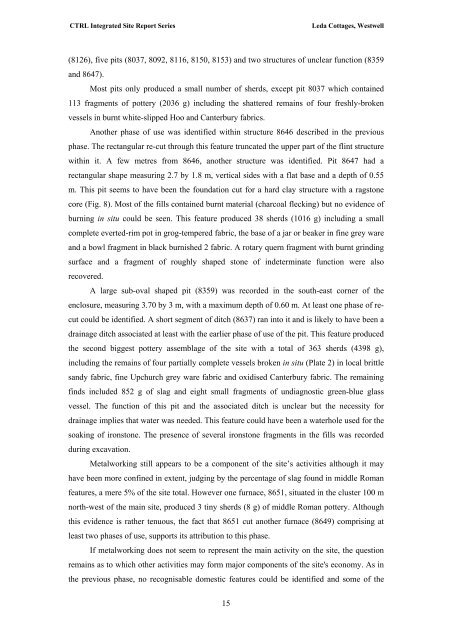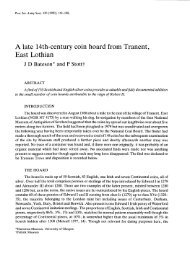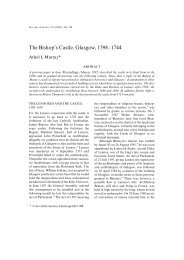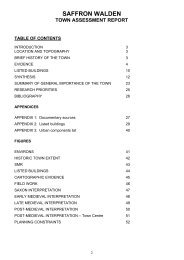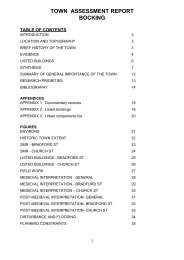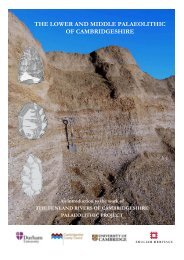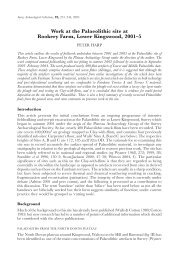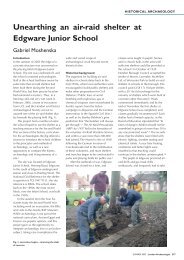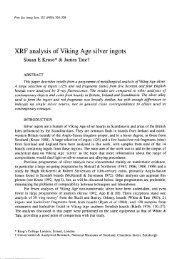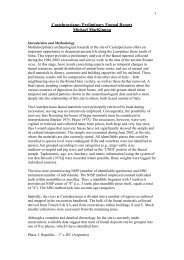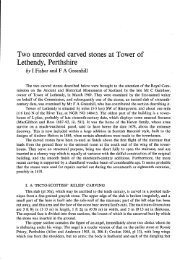The late Iron Age and Roman settlement at Leda Cottages, Westwell ...
The late Iron Age and Roman settlement at Leda Cottages, Westwell ...
The late Iron Age and Roman settlement at Leda Cottages, Westwell ...
Create successful ePaper yourself
Turn your PDF publications into a flip-book with our unique Google optimized e-Paper software.
CTRL Integr<strong>at</strong>ed Site Report Series <strong>Leda</strong> <strong>Cottages</strong>, <strong>Westwell</strong><br />
(8126), five pits (8037, 8092, 8116, 8150, 8153) <strong>and</strong> two structures of unclear function (8359<br />
<strong>and</strong> 8647).<br />
Most pits only produced a small number of sherds, except pit 8037 which contained<br />
113 fragments of pottery (2036 g) including the sh<strong>at</strong>tered remains of four freshly-broken<br />
vessels in burnt white-slipped Hoo <strong>and</strong> Canterbury fabrics.<br />
Another phase of use was identified within structure 8646 described in the previous<br />
phase. <strong>The</strong> rectangular re-cut through this fe<strong>at</strong>ure trunc<strong>at</strong>ed the upper part of the flint structure<br />
within it. A few metres from 8646, another structure was identified. Pit 8647 had a<br />
rectangular shape measuring 2.7 by 1.8 m, vertical sides with a fl<strong>at</strong> base <strong>and</strong> a depth of 0.55<br />
m. This pit seems to have been the found<strong>at</strong>ion cut for a hard clay structure with a ragstone<br />
core (Fig. 8). Most of the fills contained burnt m<strong>at</strong>erial (charcoal flecking) but no evidence of<br />
burning in situ could be seen. This fe<strong>at</strong>ure produced 38 sherds (1016 g) including a small<br />
complete everted-rim pot in grog-tempered fabric, the base of a jar or beaker in fine grey ware<br />
<strong>and</strong> a bowl fragment in black burnished 2 fabric. A rotary quern fragment with burnt grinding<br />
surface <strong>and</strong> a fragment of roughly shaped stone of indetermin<strong>at</strong>e function were also<br />
recovered.<br />
A large sub-oval shaped pit (8359) was recorded in the south-east corner of the<br />
enclosure, measuring 3.70 by 3 m, with a maximum depth of 0.60 m. At least one phase of recut<br />
could be identified. A short segment of ditch (8637) ran into it <strong>and</strong> is likely to have been a<br />
drainage ditch associ<strong>at</strong>ed <strong>at</strong> least with the earlier phase of use of the pit. This fe<strong>at</strong>ure produced<br />
the second biggest pottery assemblage of the site with a total of 363 sherds (4398 g),<br />
including the remains of four partially complete vessels broken in situ (P<strong>l<strong>at</strong>e</strong> 2) in local brittle<br />
s<strong>and</strong>y fabric, fine Upchurch grey ware fabric <strong>and</strong> oxidised Canterbury fabric. <strong>The</strong> remaining<br />
finds included 852 g of slag <strong>and</strong> eight small fragments of undiagnostic green-blue glass<br />
vessel. <strong>The</strong> function of this pit <strong>and</strong> the associ<strong>at</strong>ed ditch is unclear but the necessity for<br />
drainage implies th<strong>at</strong> w<strong>at</strong>er was needed. This fe<strong>at</strong>ure could have been a w<strong>at</strong>erhole used for the<br />
soaking of ironstone. <strong>The</strong> presence of several ironstone fragments in the fills was recorded<br />
during excav<strong>at</strong>ion.<br />
Metalworking still appears to be a component of the site’s activities although it may<br />
have been more confined in extent, judging by the percentage of slag found in middle <strong>Roman</strong><br />
fe<strong>at</strong>ures, a mere 5% of the site total. However one furnace, 8651, situ<strong>at</strong>ed in the cluster 100 m<br />
north-west of the main site, produced 3 tiny sherds (8 g) of middle <strong>Roman</strong> pottery. Although<br />
this evidence is r<strong>at</strong>her tenuous, the fact th<strong>at</strong> 8651 cut another furnace (8649) comprising <strong>at</strong><br />
least two phases of use, supports its <strong>at</strong>tribution to this phase.<br />
If metalworking does not seem to represent the main activity on the site, the question<br />
remains as to which other activities may form major components of the site's economy. As in<br />
the previous phase, no recognisable domestic fe<strong>at</strong>ures could be identified <strong>and</strong> some of the<br />
15


